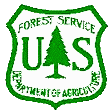
Chapter 2
Ecological Subregions of the United
States
| Back |  |  Contents |  | Forward |
 | Chapter 2 |
|
Bering Tundra (Northern)
Two Sections have been delineated in this Province:125A--Kotzebue Sound Lowlands
125B--Yukon-Kuskokwim DeltaThese Sections, located in western Alaska bordering the Bering Sea, include the islands of St. Lawrence, St. Matthew, and Nuviak. The area of these Sections is about 46,900 mi2 (121,500 km2).
Section 125A--Kotzebue Sound Lowlands
Geomorphology. Flat, poorly drained coastal plains dominated by terraces, low hills, stabilized and active dune fields. The many thaw lakes and sinks are connected by a maze of waterways. Pingos are abundant in the lowland around the Selawik River. Elevation is less than 330 ft (100 m).
Lithology and Stratigraphy. Most of the area is underlain by morainal, stream, or lake deposits of unknown thickness. End moraines of pre-Wisconsin glacial advances are common. Cenozoic and Cretaceous marine sedimentary rocks prevail.
Soil Taxa. Soils are wet and shallow to permafrost. Dominant soils are Histic Pergelic Cryaquepts and Pergelic Cryofibrists. Soils are formed from stratified silty or sandy alluvial deposits, as well as volcanic ash and loess.
Potential Natural Vegetation. Since standing water is almost always present, wet tundra communities consisting of sedge mats predominate. Peat ridges, drainage ways, and polygonal features provide better drainage upon which woody plants like white spruce, willows, alder, and paper birch occur. Black spruce forests are abundant along the Kobuk River, whereas grasses grow on the dunes along the coast.
Fauna. Spectacled eiders, ruddy turnstones, and black turnstones are common breeding birds in the lowland tundra portions of this Section. The rare Arctic loon breeds only in western Alaska and is characteristic of this area. The snowy owl is the major avian predator and, with the Arctic fox, preys on populations of Alaskan hares. Polar bears extend into this Section from the Arctic Tundra Province. Wood frogs have been recorded east of Kotzebue Sound. This Section is the most northern range of king, sockeye, and silver salmon. Chum salmon runs in the Noatak and Kobuk Rivers provide substantial commercial and subsistence harvests. Sheefish in the Kobuk-Selawik river systems are the slowest growing, longest lived, and largest of Alaska sheefish.
Climate. Average annual precipitation ranges from 7 to 12 in (180 to 300 mm). Average annual temperature ranges from 20 to 23 oF (-7 to -5 oC). The growing season is approximately from June 1 to September 15.
Surface Water Characteristics. Lakes and ponds make up 15 to 20 percent of the area. Soils underlain by permafrost are nearly always saturated in the summer. Permafrost is deep or absent and soils are well drained in natural levees and sand dunes. Spring flooding along rivers and tidal inundation along the coasts are common. Wetlands occupy 76 percent of the area.
Disturbance Regimes. Riparian disturbance is prevalent during spring break-up and summer storms that cause flooding in surrounding lowlands.
Land Use. Isolated human disturbance occurs around small permanent and seasonal settlements scattered throughout the Section, particularly along the coastline and larger rivers.
Cultural Ecology. Inupiaq Eskimos reside here.
Compiled by Alaska Region.
Top
Section 125B--Yukon-Kuskokwim Delta
Geomorphology. The area is a lake-dotted marshy plain with many low hills of basalt and volcanic cinder cones and craters. Elevation is less than 400 ft (120 m).Lithology and Stratigraphy. The lowland is underlain by post-accreted Quaternary sands and silts to unknown depth. Basalt flows and cinder cones of Tertiary and Quaternary age exist. Other bedrock consists of Cenozoic sedimentary rocks with inclusions of various other assemblages.
Soil Taxa. Dominant soils are Histic Pergelic Cryaquepts and Pergelic Cryofibrists. Soils are shallow over permafrost and consistently wet.
Potential Natural Vegetation. Wet tundra communities consisting primarily of sedge mats, moss, and low growing shrubs predominate. Alder, willows, and scattered, stunted spruce and birch grow along the major streams.
Fauna. The lakes, streams, and tidal flats interspersed with tundra and sedge flats make this Section exceptional habitat for waterfowl, shorebirds, and furbearers. The Yukon-Kuskokwim Delta supports the highest densities of nesting tundra swans, most of the world's population of emperor swans, and one-half of the total population of black brant. All of North America's cackling Canada geese are produced in these coastal lowlands. Spectacled eiders are common north of the Kuskokwim River. The only known breeding grounds of the very rare bristle-thighed curlew extend through this Section. Although rare, white wagtails are characteristic breeders in open areas along the coast. Dovekies and McKay's buntings are limited in Alaska to off-shore islands included in this Section. River otters are abundant; short-tailed and least weasels are common. Ribbon seals are characteristic of areas off-shore. Large numbers of barren-ground caribou inhabited this Section up until the mid-1800's. Limited numbers of caribou associated with herds from other Sections now occur in this area. The musk ox was introduced to Nunivak Island in 1935 and 1936. Wood frogs have been reported from the eastern portion of this Section. All three forms of Arctic char (anadromous, resident stream, resident lake) occur here. Sheefish are associated with both the Yukon and Kuskokwim rivers. All five species of North American Pacific salmon are indigenous to this Section; chum salmon are the most abundant.
Climate. Average annual precipitation ranges from 15 to 22 in (380 to 560 mm). Average annual temperature ranges from 25 to 31 oF (-4 to -1 oC). The growing season is approximately from June 1 to September 15.
Surface Water Characteristics. The lowland is crossed by meandering streams of extremely low gradient. Many are tributaries or former channels of the Yukon or Kuskokwim Rivers. Wetlands occupy over 78 percent of the area.
Disturbance Regimes. Occurrence of wildfires is low.
Land Use. Only small permanent and seasonal settlements occur along the rivers and coast. The region is used for subsistence and recreational hunting and fishing.
Cultural Ecology. Yupik Eskimos reside in this Section.
Compiled by Alaska Region.
Top
Back
ContentsForward